Ganesha Ashtothram is a sacred Hindu devotional text, containing 108 profound names of Lord Ganesha, symbolizing his divine attributes and blessings. Widely revered, it is often recited for spiritual growth, obstacle removal, and seeking prosperity. Available as a convenient PDF, it simplifies access for modern worshippers, fostering a deeper connection with Ganesha’s auspicious energy and teachings.
1.1. What is Ganesha Ashtothram?
Ganesha Ashtothram is a revered Hindu devotional text comprising 108 sacred names of Lord Ganesha, each signifying his divine attributes and blessings. It is a poetic recitation that embodies the essence of Ganesha’s auspicious nature, wisdom, and remover of obstacles. This sacred hymn is often chanted in rituals and daily worship to invoke Ganesha’s grace. The PDF format of Ganesha Ashtothram is widely popular, offering easy access for devotees to recite and meditate on these powerful names. It serves as a spiritual tool for seeking prosperity, clarity, and inner peace, while fostering a deeper connection with Ganesha’s divine energy and teachings.
1.2. Importance of Ashtothram in Hindu Worship
Ganesha Ashtothram holds profound significance in Hindu worship, serving as a powerful tool for spiritual growth and divine connection. It is a revered practice where devotees recite 108 sacred names of Ganesha, each embodying his divine attributes. This ritual is believed to remove obstacles, bring prosperity, and foster inner peace. The PDF format of Ganesha Ashtothram has made it accessible for daily recitation, enabling devotees to incorporate it into their worship routines seamlessly. By focusing on Ganesha’s auspicious energy, the Ashtothram strengthens faith, enhances mindfulness, and deepens the practitioner’s spiritual journey, making it an integral part of Hindu devotional practices and rituals.
1.3. Overview of the Structure and Content
Ganesha Ashtothram is a devotional hymn comprising 108 sacred names of Lord Ganesha, each reflecting his divine qualities and attributes. The structure includes invocations, praises, and blessings, while the content emphasizes his role as the remover of obstacles. The PDF format typically features the Namavali, a list of names, along with their meanings and spiritual significance. The text is often accompanied by mantras, which are chanted for auspiciousness and spiritual growth. This structured composition makes it easy for devotees to recite and understand, fostering a deep connection with Ganesha’s divine energy and blessings, while the digital format ensures accessibility for modern worshippers.
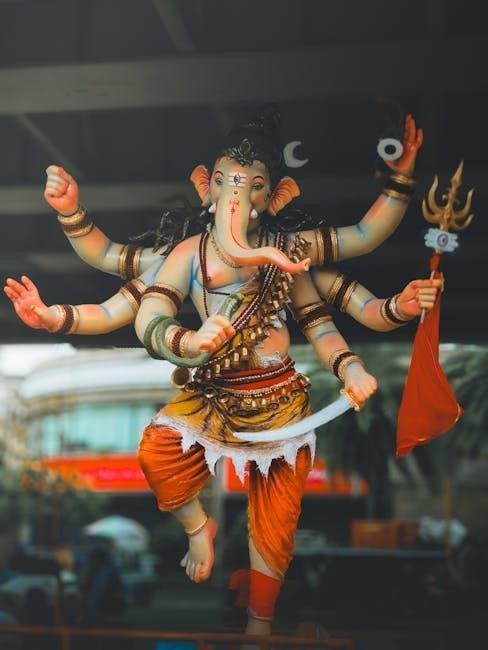
Significance of Ganesha Ashtothram
Ganesha Ashtothram holds deep spiritual significance, offering divine blessings, obstacle removal, and inner peace. Its accessible PDF format facilitates daily recitation, promoting devotion and harmony in life.
2.1. The Number of Names in Ashtothram
Ganesha Ashtothram consists of 108 sacred names, each reflecting Lord Ganesha’s divine attributes and blessings. The number 108 holds spiritual significance in Hinduism, symbolizing completeness and cosmic order. These names, often recited for worship, embody Ganesha’s role as the remover of obstacles and the granter of wisdom. The PDF format of Ganesha Ashtothram makes it easily accessible, allowing devotees to recite these names with devotion. Each name highlights a unique facet of Ganesha, from his strength to his benevolence, fostering a deeper connection with his divine energy.
2.2. Spiritual and Ritual Significance
Ganesha Ashtothram holds profound spiritual and ritual significance, as it embodies the divine essence of Lord Ganesha. Reciting these 108 names is believed to purify the mind, remove obstacles, and attract auspicious energies. The ritual of recitation is often performed during ceremonies and daily worship to invoke Ganesha’s blessings for success and prosperity. The PDF format of Ganesha Ashtothram has made it accessible for devotees to perform these rituals with ease. Proper recitation with concentration and devotion amplifies its spiritual impact, fostering inner peace and a deeper connection with the divine. This practice is integral to Hindu worship, reflecting faith in Ganesha’s protective grace.
2.3. The Role of Ganesha in Hinduism
Ganesha, the remover of obstacles, holds a pivotal role in Hinduism as a symbol of wisdom, prosperity, and auspicious beginnings. He is revered as the granter of knowledge and the protector of devotees. Stories from scriptures like the Ganesha Purana highlight his triumphs, reinforcing his divine status. Ganesha’s imagery, with an elephant head, embodies adaptability and strength. His worship, including reciting the Ashtothram, is integral to Hindu rituals, seeking blessings for success and harmony. The PDF format of Ganesha Ashtothram aids devotees in performing these rituals effortlessly, connecting them to Ganesha’s divine grace and teachings. His universal appeal transcends cultural boundaries, making him a beloved deity globally.
2.4. Ashtothram and Its Connection to Karma and Dharma
Ganesha Ashtothram is deeply linked to the Hindu principles of Karma and Dharma, emphasizing righteous actions and moral duties. Reciting the Ashtothram aligns devotees with their Dharma, fostering a path of ethical living and spiritual balance. It reflects the belief that worship influences Karma, guiding individuals toward positive actions and outcomes. The PDF format of Ganesha Ashtothram simplifies access to these sacred verses, enabling devotees to integrate them into daily rituals. This practice not only seeks material prosperity but also cultivates inner harmony and adherence to Dharma. The connection to Tri Shaktis and Trividha further underscores its role in anchoring the mind in divine consciousness, aligning with the teachings of Hindu scriptures.
Structure of Ganesha Ashtothram
Ganesha Ashtothram’s structure combines devotion and philosophy, featuring 108 divine names, a Namavali, and sacred mantras. Each element carries profound meaning, available conveniently in a PDF format.

3.1. The 108 Names of Ganesha
The 108 names of Ganesha, as detailed in the Ashtothram, symbolize his divine attributes and blessings. Each name reflects his role as the remover of obstacles, bestower of wisdom, and embodiment of auspiciousness. These names, carefully curated, highlight Ganesha’s multifaceted nature, from his physical form to his spiritual significance. The PDF format of the Ashtothram provides easy access to these sacred names, aiding devotees in recitation and reflection. Each name carries profound meaning, offering spiritual solace, prosperity, and inner peace. Reciting these names with devotion is believed to invoke Ganesha’s blessings, fostering a deeper connection with the divine. This structured enumeration is a cornerstone of Ganesha worship.
3.2. The Namavali and Its Meaning
The Namavali, or the list of names, in the Ganesha Ashtothram, holds deep spiritual significance. Each name in the Namavali represents a unique attribute of Lord Ganesha, reflecting his role as the remover of obstacles and the granter of wisdom. The names are not just labels but powerful mantras that embody his divine essence. The Namavali serves as a spiritual tool, helping devotees connect with Ganesha on a deeper level. The structured repetition of these names fosters devotion and mindfulness, while their meanings offer insights into Ganesha’s universal appeal. The PDF format makes this sacred text accessible, allowing devotees to recite and reflect on the 108 names with ease and reverence.
3.3. The Role of Mantras in Ashtothram
Mantras in Ganesha Ashtothram are powerful sound vibrations that hold spiritual significance. Each mantra is a invocation of Lord Ganesha, embodying his divine attributes and blessings. The recitation of these mantras is believed to purify the mind, remove obstacles, and grant spiritual enlightenment. The structured chanting of these mantras in the Ashtothram creates a sacred rhythm, fostering devotion and inner peace. The PDF format ensures easy access to these mantras, allowing devotees to recite them with clarity and precision. The mantras are not just words but a bridge to the divine, connecting worshippers with Ganesha’s auspicious energy and universal wisdom.

Benefits of Reciting Ganesha Ashtothram
Reciting Ganesha Ashtothram offers numerous benefits, including obstacle removal, spiritual growth, and inner peace. It is believed to grant prosperity, protection, and divine blessings, enhancing overall well-being and success.
4.1. Removing Obstacles and Ensuring Success
Reciting Ganesha Ashtothram is a powerful way to remove obstacles and ensure success in life. Lord Ganesha, the remover of hurdles, is invoked through these sacred names, which are believed to clear the path for achieving goals. The recitation is said to bring auspicious energy, fostering positive outcomes in personal and professional endeavors. By chanting these names, devotees seek divine intervention to overcome challenges and attain prosperity. The Ashtothram’s spiritual significance lies in its ability to create a protective shield of blessings, guiding individuals toward success and fulfillment while maintaining harmony and balance in life.
4.2. Spiritual Growth and Inner Peace
Reciting Ganesha Ashtothram fosters spiritual growth by aligning one’s mind with divine energy; The sacred names evoke mindfulness and inner harmony, helping devotees cultivate a deeper connection with their spirituality. Regular recitation enhances self-awareness, promoting emotional balance and mental clarity. It also strengthens faith, enabling individuals to embrace life’s challenges with resilience. The Ashtothram’s rhythmic chanting creates a meditative state, allowing the soul to experience tranquility. By focusing on Ganesha’s attributes, such as wisdom and auspiciousness, practitioners achieve inner peace and a sense of unity with the universe. This spiritual practice becomes a pathway to enlightenment and eternal bliss, reflecting Ganesha’s divine grace.
4.3. Wealth and Prosperity Through Worship
Reciting Ganesha Ashtothram is believed to attract wealth and prosperity by invoking Lord Ganesha’s blessings. As the remover of obstacles, Ganesha ensures smooth progress in all endeavors, leading to financial success. Devotees often recite the Ashtothram to seek his grace for abundance and material well-being. The sacred hymn is also said to enhance one’s ability to manage resources wisely, fostering economic stability. By worshiping Ganesha with sincerity, individuals align themselves with the principles of Dharma and Karma, which are essential for sustainable prosperity. The Ashtothram’s divine energy resonates with the universe, channeling positive vibrations that attract wealth and good fortune, reflecting Ganesha’s role as the bestower of auspicious beginnings.
4.4. Protection and Blessings from Ganesha
Reciting Ganesha Ashtothram is a powerful way to seek Lord Ganesha’s protection and blessings. As the remover of obstacles, Ganesha shields devotees from negative energies and adversities. His blessings bring harmony and peace, ensuring a secure and prosperous life. The Ashtothram’s sacred verses create a protective aura, warding off evil influences and fostering a balanced existence. By invoking Ganesha’s grace, individuals gain the strength to navigate life’s challenges with confidence. The hymn’s recitation not only protects but also bestows divine blessings, aligning one’s actions with Dharma and Karma. This spiritual practice strengthens faith and offers a sense of safety and divine anchoring in daily life.
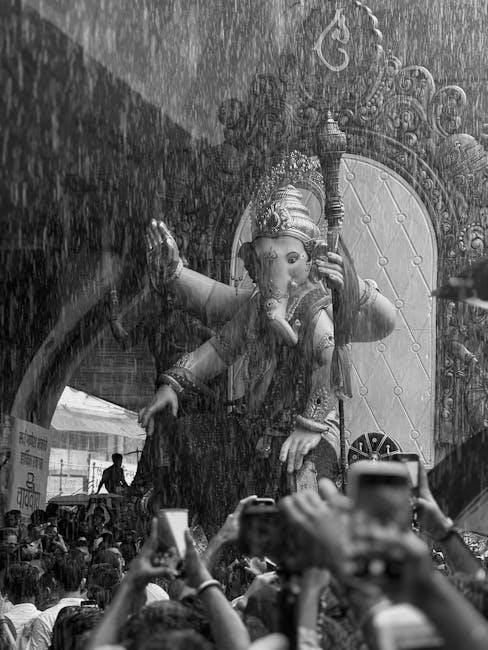
How to Use the Ganesha Ashtothram PDF
The Ganesha Ashtothram PDF is easily accessible online, offering a convenient format for daily recitation. Set aside a quiet time, focus on pronunciation, and recite with devotion to foster a deep spiritual connection with Lord Ganesha.
5.1. Where to Find the Ganesha Ashtothram PDF
The Ganesha Ashtothram PDF is readily available online, making it accessible to devotees worldwide. Popular platforms like Google, religious websites, and e-book repositories offer free downloads. Many Hindu temples and spiritual organizations also provide these PDFs on their official websites. Additionally, apps and forums dedicated to Hindu scriptures often include downloadable versions. Users can search using keywords like “Ganesha Ashtothram PDF” or “Ganesha Ashtottara Namavali PDF” to find reliable sources. Ensure the PDF is from a credible site to maintain authenticity and proper formatting for smooth recitation and worship.
5.2. How to Recite the Ashtothram Daily
Reciting the Ganesha Ashtothram daily is a simple yet powerful practice. Begin by setting aside a quiet time, ideally during early morning or evening, for uninterrupted worship. Sit comfortably with a focused mind, light a lamp or incense to create a sacred atmosphere. Open the Ganesha Ashtothram PDF and recite each name with clarity and devotion, pausing briefly after each to absorb its spiritual significance. Maintain concentration to ensure proper pronunciation and mindset; Regular recitation fosters discipline and enhances the spiritual experience. Conclude with a heartfelt prayer, seeking Ganesha’s blessings for guidance and prosperity.
5.3. The Importance of Concentration and Pronunciation
Concentration and correct pronunciation are vital for the effective recitation of Ganesha Ashtothram. A focused mind ensures the recitation is meaningful and spiritually impactful, fostering a deeper connection with the divine. Proper pronunciation preserves the potency of the mantras, as mispronunciation may dilute their spiritual significance. Practice reciting slowly and clearly, especially when using the Ganesha Ashtothram PDF, to maintain accuracy. This discipline enhances the ritual’s efficacy, allowing the worshipper to fully immerse in the devotion and reap the benefits of Ganesha’s blessings. Regular practice strengthens both focus and pronunciation, making the recitation a powerful tool for spiritual growth and divine alignment.
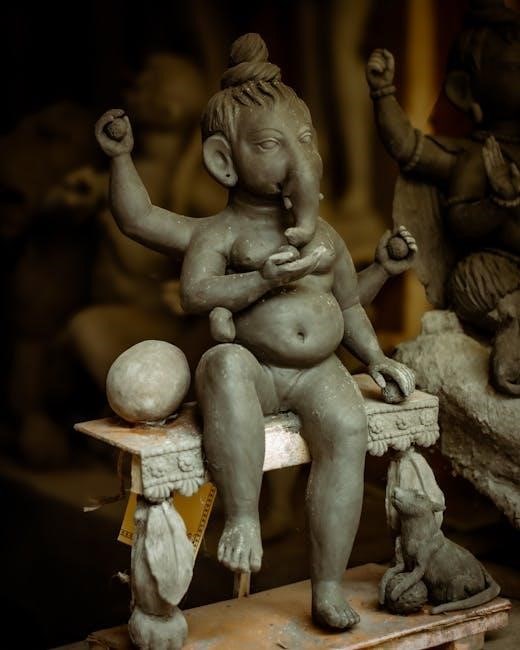
Combining Ganesha Worship with Other Deities
Ganesha worship can be harmoniously combined with other deities like Hanuman, fostering spiritual balance and enhancing blessings. This unified approach strengthens devotion and fulfills desires effectively.
6.1. Ganesha and Hanuman Worship Together
Ganesha and Hanuman worship together symbolize a harmonious blend of auspiciousness and strength. Ganesha, the remover of obstacles, and Hanuman, the embodiment of devotion and courage, complement each other beautifully. This combined worship enhances spiritual growth, fosters resilience, and attracts divine blessings. Devotees often recite Ganesha Ashtothram alongside Hanuman Chalisa to create a balanced practice. The mindset for such worship emphasizes unity, focus, and sincerity. It is believed that this dual devotion strengthens one’s connection to the divine, offering protection, success, and inner peace. The practice also reflects the broader Hindu philosophy of integrating diverse energies for holistic worship.
6.2. Requirements for Combined Rituals
Combined rituals of Ganesha and Hanuman require a purified space, a focused mindset, and adherence to specific practices. Devotees must ensure the area is clean and free from distractions. The recitation of Ganesha Ashtothram and Hanuman Chalisa should be performed with proper pronunciation and devotion. Offerings such as flowers, incense, and prasad are essential, symbolizing respect and gratitude. Maintaining consistency in daily worship fosters a deeper spiritual connection. The integration of these rituals emphasizes harmony, balance, and the unity of divine energies. It is crucial to approach the practice with sincerity and purity of intention for optimal spiritual benefits.
6.3. Daily Worship Practices
Daily worship practices for combining Ganesha and Hanuman rituals involve starting with purification rituals and lighting a lamp. Recite Ganesha Ashtothram and Hanuman Chalisa with devotion, offering flowers and incense. Maintain a clean and sacred space, ensuring consistency in worship timing. Perform aarti and offer prasad to both deities. Focus on sincerity and concentration to harness spiritual benefits. This harmonious practice strengthens faith, fosters divine connection, and brings balance to daily life, ultimately seeking the blessings of both Ganesha and Hanuman for prosperity and protection.

The Role of Ganesha in Hindu Scriptures
Ganesha is revered in Hindu scriptures like the Ganesha Purana, showcasing his divine attributes and triumphs. His stories highlight wisdom, auspiciousness, and cultural significance, embodying spiritual and philosophical teachings.
7.1. Ganesha Purana and Its Teachings
The Ganesha Purana is a revered Hindu scripture that narrates the life, attributes, and divine deeds of Lord Ganesha. It describes his triumph over the Daitya Sindura, symbolizing the conquest of evil. The text emphasizes Ganesha’s role as a remover of obstacles and a symbol of auspiciousness. It also explores philosophical themes, such as the essence of the universe and the balance of cosmic energies. The Purana highlights Ganesha’s unique qualities, making him a central figure in Hindu worship and spirituality. Its teachings align with the recitation of the Ganesha Ashtothram, reflecting his divine attributes and the mindset for worship.
7.2. Stories of Ganesha’s Triumphs
Ganesha’s triumphs, as depicted in Hindu scriptures, highlight his divine prowess and wisdom. One notable story is his victory over the Daitya Sindura, whose blood smeared on Ganesha’s body symbolizes the defeat of evil. Another tale is his role in writing the Mahabharata, showcasing his intelligence and dedication. These stories underscore Ganesha’s dual nature: a remover of obstacles and a bestower of wisdom. His triumphs inspire devotion and reflect his role as a protector and guide. The Ganesha Ashtothram resonates with these narratives, celebrating his attributes and reinforcing his significance in Hindu worship and spiritual practices. His stories embody divine grace and enduring inspiration.
7.3. The Symbolism of Ganesha in Hinduism
Ganesha embodies profound symbolism in Hinduism, representing auspiciousness, endeavor, and success. His large ears signify the importance of listening and understanding, while his trunk symbolizes adaptability and problem-solving. The broken tusk highlights sacrifice and unwavering focus. Ganesha’s modak represents the sweetness of spiritual knowledge and worldly pleasures. As Vinayaka, he is the remover of obstacles, guiding devotees toward their goals. His symbolism extends to the concept of Tri Shaktis and Trividha, reflecting the harmony of divine energies. Ganesha’s image and stories inspire devotion, emphasizing wisdom, resilience, and the pursuit of dharma. His universal appeal transcends rituals, making him a beloved deity across cultures and generations.
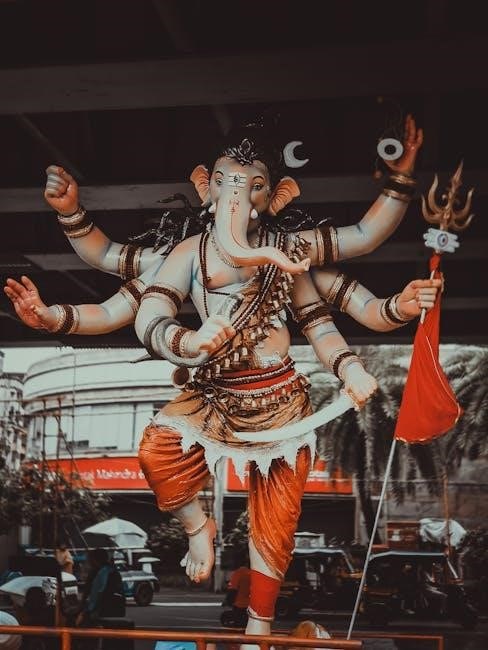
The Connection Between Ashtothram and Spirituality
Ganesha Ashtothram deeply connects spirituality by anchoring the mind in divine consciousness. Recitation fosters a mindset of devotion, emphasizing Tri Shaktis and Trividha, leading to inner peace and spiritual growth.
8.1. The Mindset for Worship
The mindset for worship, as emphasized in Ganesha Ashtothram, revolves around devotion, focus, and a pure heart. Reciting the 108 names requires concentration and the right approach to connect with Ganesha’s divine energy. It is not merely about rituals but fostering a deep spiritual connection. Understanding Hindu philosophies like Dharma and Karma helps in embracing the true essence of worship. The mindset should be calm, reflective, and open, allowing the devotee to absorb the spiritual significance of each name. This focused approach ensures that the recitation becomes a meaningful journey toward inner peace and divine anchoring, aligning with Ganesha’s teachings of auspiciousness and success.
8.2. The Concept of Tri Shaktis and Trividha
Ganesha embodies the essence of Tri Shaktis—creative, preservative, and destructive energies—and Trividha, representing the threefold aspects of existence. These concepts symbolize the harmony and balance Ganesha maintains in the universe. The Tri Shaktis are often linked to the Trimurti (Brahma, Vishnu, Shiva), while Trividha reflects the three states of human consciousness. Worshiping Ganesha with this understanding connects devotees to his universal appeal, emphasizing his role as a remover of obstacles and a symbol of auspiciousness. This duality underscores Ganesha’s significance in both spiritual and material realms, making him a revered deity in Hindu worship and philosophy.
8.3. The Focus on Divine Anchoring
Divine anchoring is a spiritual practice emphasizing focus on the divine to stabilize the mind and soul. In Ganesha worship, this concept is reflected in the unwavering devotion to his form and attributes. The Saptaṛṣis’ focus on Gaṇeśa symbolizes this anchoring, highlighting its importance in maintaining spiritual equilibrium. Reciting the Ganesha Ashtothram helps anchor the mind, fostering concentration and reducing worldly distractions. This practice aligns the devotee with cosmic energies, promoting inner peace and clarity. By anchoring oneself in Ganesha’s divine presence, one achieves spiritual harmony and a deeper connection to the universe, reinforcing the essence of worship and devotion.

The Role of Ganesha in Modern Worship
Ganesha remains a central figure in contemporary Hindu practices, symbolizing auspiciousness and success. His universal appeal transcends traditions, making him a beloved deity in modern spiritual and cultural contexts.
9.1. Ganesha in Contemporary Hindu Practices
Ganesha remains a central figure in modern Hindu worship, revered for his universal appeal and blessings. Contemporary practices often blend traditional rituals with digital resources, such as the Ganesha Ashtothram PDF, to make worship accessible. Many devotees incorporate daily recitations of the Ashtothram into their routines, seeking spiritual growth and obstacle removal. The deity’s symbolism of auspiciousness and success resonates deeply in today’s fast-paced world. Additionally, Ganesha’s worship is often combined with other deities, reflecting the evolving nature of Hindu spirituality. His influence extends beyond rituals, inspiring mindfulness and divine focus, making him a timeless and integral part of modern Hindu practices.
9.2. The Influence of Ganesha on Daily Life
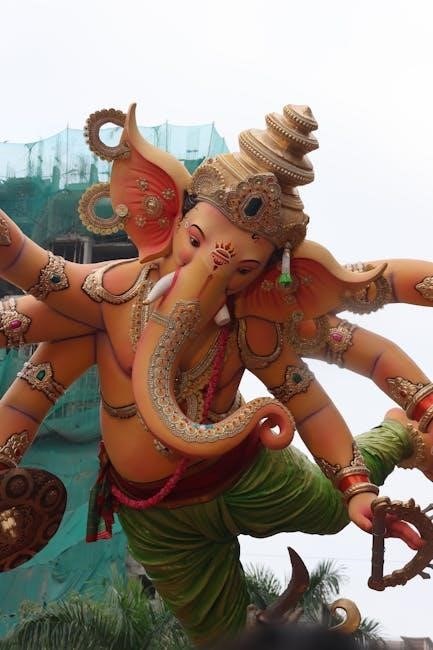
Ganesha’s influence on daily life is profound, inspiring positivity and resilience. His attributes of auspiciousness and wisdom guide devotees in navigating life’s challenges. Many incorporate the Ganesha Ashtothram PDF into daily rituals, fostering a mindset of gratitude and focus. The deity’s emphasis on ethical behavior and success encourages individuals to uphold Dharma and Karma, aligning actions with moral integrity. Ganesha’s symbolism also promotes divine anchoring, helping individuals maintain spiritual balance amidst life’s chaos. His universal appeal makes him a beloved figure, influencing daily decisions and aspirations, ensuring his relevance in modern Hindu practices and beyond.
9.3. The Universality of Ganesha’s Appeal
Ganesha’s appeal transcends cultural and religious boundaries, making him a universally revered deity. His endearing qualities, such as wisdom and adaptability, resonate with people globally. The Ganesha Ashtothram PDF has further amplified his reach, enabling devotees worldwide to access and recite his hymns. His role as an obstacle remover and symbol of auspiciousness connects individuals from diverse backgrounds. Stories of his triumphs, like defeating Daitya Sindura, highlight his strength and divine grace. Ganesha’s teachings on Dharma and Karma inspire ethical living and spiritual growth, making him a beloved figure across cultures, embodying hope and new beginnings for all.
Ganesha Ashtothram remains a vital part of Hindu worship, offering spiritual growth, obstacle removal, and divine blessings. Its accessibility via PDF ensures timeless relevance, fostering universal devotion to Ganesha.
10.1. The Enduring Significance of Ganesha Ashtothram
Ganesha Ashtothram holds enduring significance as a sacred text in Hinduism, offering profound spiritual insights and divine connection. Its 108 names encapsulate Ganesha’s attributes, fostering devotion and blessings. Stories from scriptures like Ganesha Purana highlight his triumphs, reinforcing his role as a remover of obstacles. The symbolism of Ganesha, representing auspiciousness and dharma, resonates deeply with worshippers. Available as a PDF, it bridges tradition with modern accessibility, ensuring its teachings remain relevant. Through daily recitation, devotees seek inner peace, prosperity, and spiritual growth, anchoring their faith in Ganesha’s timeless wisdom.
10.2. Final Thoughts on Worship and Spirituality
Worship and spirituality are deeply intertwined in Hinduism, with Ganesha Ashtothram serving as a powerful tool for divine connection. The text emphasizes balancing rituals with mental focus, fostering a mindset rooted in devotion and understanding. The concept of Tri Shaktis and Trividha highlights the pursuit of divine anchoring, guiding believers toward spiritual growth. Available as a PDF, Ganesha Ashtothram simplifies access to sacred chants, enabling modern worshippers to integrate its teachings into daily life. This practice not only honors Ganesha but also nurtures inner peace, reinforcing the universal appeal of his blessings and wisdom in a contemporary world.
